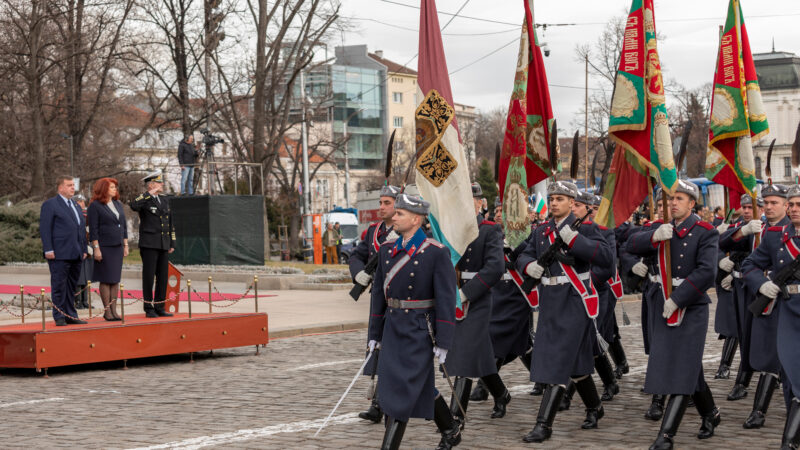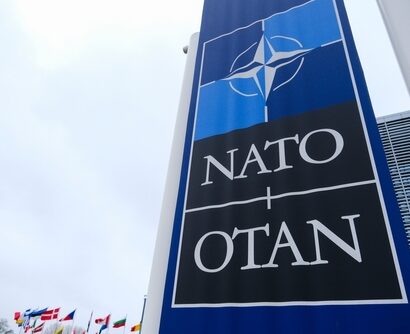Abstract: An ad-hoc working group associated with the European Initiative for the Exchange of Young Officers was tasked to develop the SQF-MILOF.[1] Based on the EQF[2] and European officers’ career development principles, SQF-MILOF defines the qualification requirements and the learning outcomes for the education and training conducted during officers’ life cycle. In the validation stage, the defined learning outcomes of the SQF were compared with the requisites of the existing educational documentation supporting military education, which are in line with the Bulgarian national qualification requirements. This study aims to define the key learning outcomes in the NVNA cadet’s curriculum and match them with the competence profile and the taxonomy of learning outcomes in SQF-MILOF. As a result of matching, the level of education and qualification and the organisational focus in NVNA education and training according to SQF-MILOF. The findings reveal that SQF-MILOF is well set up according to the Bulgarian national qualification requirements.
Problem statement: How does the cadet curriculum of a higher educational institution, such as NVNA, correspond to SQF-MILOF categorization?
Bottom-line-up-front: The NVNA cadet’s curriculum is levelled as follows:
- equivalent to EQF Level 6; and
- focused on Single Arm/Branch (low tactical level).
That proves the suppositions in the competence profile and the taxonomy of learning outcomes in SQF-MILOF in the early development stage – an informal validation of the SQF-MILOF is successful.
So what?: The existing cadet’s curriculum should be analysed to present the legal base of its definition.
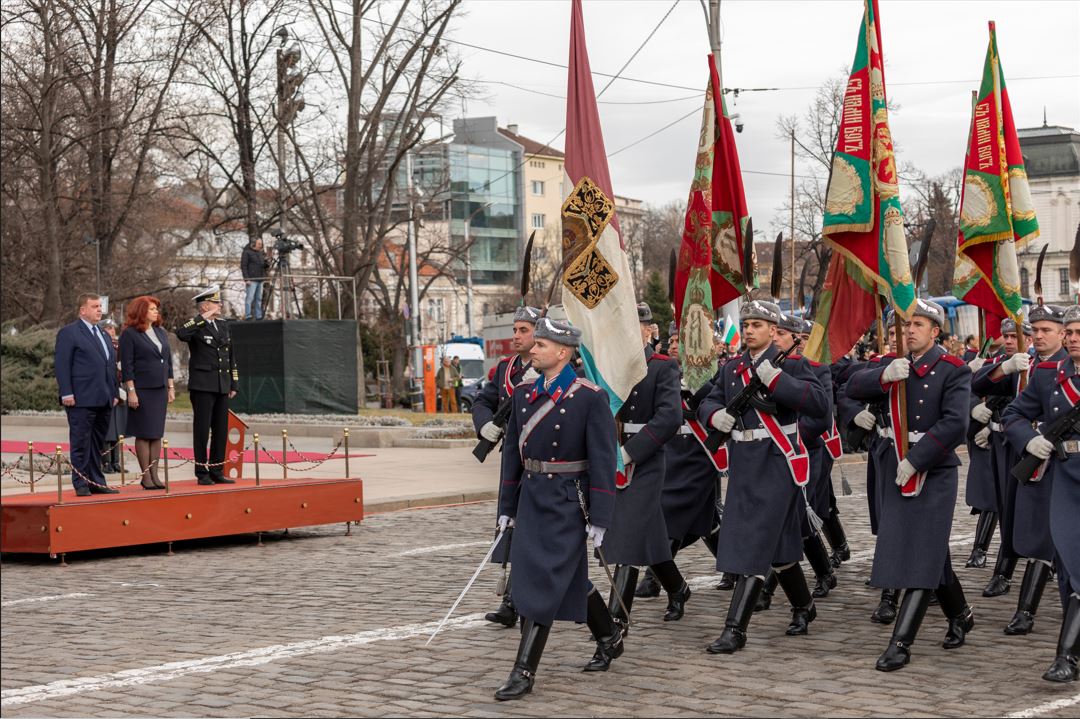
Source: shutterstock.com/djumanji
Need and Development of SQF-MILOF
From 2009 to 2014, the European Security and Defence College (ESDC) developed the first stage of the SQF-MILOF. This was in the context of the European Initiative for the Exchange of Young Officers inspired by Erasmus (Military Erasmus Program). The project, known as ‘Comparison of courses based on competencies’, was focused on the beginning of the military officer career. However, the Implementation Group[3] (IG) proposed that a comprehensive framework be developed to cover all critical stages of the military officer career.
The former Chairman of the European Union Military Committee, General Mickail Kostarakos, took the recommendations of the EU Military Training Group on board and, in July 2016, he invited the ESDC (supported by the European Union Military Staff) to consider establishing an SQF-MILOF for all levels of the military officer career. On December 15, 2017, the ESDC Secretariat invited member states to complete a questionnaire and nominate experts with relevant operational, educational, and training expertise to form an EU-level ad-hoc working group.[4] The purpose was to develop an SQF-MILOF for all levels of the military officer career.
On December 15, 2017, the ESDC Secretariat invited member states to complete a questionnaire and nominate experts with relevant operational, educational, and training expertise to form an EU-level ad-hoc working group.
The SQF-MILOF working group (WG) was convened in June 2018 under the auspices of the ESDC. During the work period, representatives of 21 member states and 13 national, international, and non-governmental organizations contributed to the process. The participants acted as input providers or as points of contact with national authorities and experts for developing SQF-MILOF.
SQF-MILOF aims to offer member states a cross-referencing tool for military qualifications so that qualifications obtained in one of the member states can be compared with similar qualifications granted by another. SQF-MILOF relates to lifelong learning for a particular sector: military officers.[5]
The WG defines SQF-MILOF as a pan-EU (transnational) qualifications framework for the military officer profession. More specifically, it is (Sectoral Qualifications Framework for the Military Officer Profession 2020):
- operationally relevant. SQF-MILOF is based on the competence profile of a generic European officer. The competence profile comprises the knowledge and skills needed in complex and multi-dimensional future operating environments. It constitutes what commanders expect from their officers in the event of unexpected and rapidly evolving internal and external security situations with military implications;
- learning relevant. SQF-MILOF describes the learning (profile)outcomes officers should reach at specific moments in their careers. It describes what officers should know, and be able to do, with a certain degree of responsibility and autonomy, to match the competence profile of a generic European officer;
- EU relevant. SQF-MILOF is designed to be aligned and compliant with the European Qualification Framework (EQF)[6] for lifelong learning. By referencing national programmes against SQF-MILOF and the EQF, member states can compare their qualifications with similar qualifications granted by another member state; and
- nationally relevant. SQF-MILOF is designed to be aligned and compliant with EU members’ National Qualification Frameworks (NQFs).[7] It is designed to be a commonly agreed tool to support the development of member states’ educational programmes and course curricula.
The SQF-MILOF has been formulated as the learning outcomes (knowledge, skills, autonomy, and responsibility) an officer should reach in the eight competence areas:
- Four areas are assessed as core competence areas and cover professional competencies specific to the sector: Military service member; Military technician; Leader and Decision-Maker, and Combat-Ready Role Model; and
- Four areas are transversal competencies, which, although not specific to the profession, are modelled and adapted according to the characteristics of the profession: Communicator; Learner and Teacher/Coach; Critical Thinker and Researcher; and International Security/Diplomacy.
![Table 1. SQF-MILOF Level Descriptors[8]](https://tdhj.org/media/0d3ede_26d65db449ff42338f1b222620bb46b5~mv2.jpg)
Table 1. SQF-MILOF Level Descriptors[8]
SQF-MILOF is built on four learning levels of complexity: Level 1[9] (equivalent to EQF 5[10]) to Level 4 (equivalent to EQF 8). The SQF-MILOF level descriptors are categories for the SQF-MILOF learning outcomes. Here, learning outcomes are high-level overarching statements intended to cover learning in all its expressions: formal education programmes, vocational training undertaken throughout the career, skills acquired on the job, experience from operations and exercises, and even informal learning from personal reading or professional and social interaction. The WG developed detailed descriptions of SQF-MILOF learning outcomes that describe the progression of learning complexity for the military officer profession, focused on military organizational architecture/operations. In this respect, the outcomes describe learning that is relevant for each of the following four dimensions:
- Single arm/branch (learning at this stage focuses on the individual and low tactical level);
- Single service (learning at this stage focuses on the tactical level);
- Joint/multiple services (learning at this stage focuses on the operational level); and
- Political/Civil-Military (learning at this stage focuses on the strategic level).
SQF-MILOF is built on four learning levels of complexity: Level 1 to Level 4. The SQF-MILOF level descriptors are categories for the SQF-MILOF learning outcomes.
Bulgarian National Officers’ Qualification Requirements
According to the national legislation, ‘Military Officer’ is a nationally regulated profession. The regulation is provided by state ordinances that set the minimum requirements for education and training of the students to become an officer at tactical[11] and operational[12] levels.
For the purposes of this paper, the author focuses on the bachelor level of education because the NVNA cadets’ curriculums correspond to exactly this level of education. Based on the cited state ordinance, the training and its results correspond to Level 6 of the NQF (equivalent to EQF 6), including a minimum of 4,200 academic hours. Compulsory study subjects are thematically divided into groups with a minimum number of hours, as follows:
- Basic military training – 150 academic hours;
- General military training – 200 academic hours;
- Special military training – 700 academic hours;
- National security, resource management, and fundamentals of law – 150 academic hours;
- Academic practice and internship – 120 academic hours; and
- Language, leadership, and physical training – 700 academic hours.
The training has to provide:
- a wide-ranging and specialized professional training in the professional field of “Military Affairs”;
- acquisition of adaptability skills according to the changing conditions of professional realization;
- acquisition of skills for independent professional work and teamwork; and
- conditions for educational mobility and international comparability of the acquired knowledge and abilities.
The NVNA cadets’ curriculum is established based on the NQF Level 6, following the state ordinance and the specific qualification requirements issued by the Ministry of Defence. The curriculum comprises 240 ECTS (European Credit Transfer and Accumulation System) and offers a formal education with no military prerequisites.
Methodology of Assessment
The assessment aims to verify the extent to which the learning outcomes described in the SQF-MILOF can be used to assign an SQF-MILOF level and define a military focus forto National Military Qualification (NMQ), or improve or refine relevant national program/course curricula leading to an NMQ. To achieve the aim, a comparative analysis is conducted following the already developed methodology.[13]
Definition of Levelling and Military Focus
Levelling NMQ to the SQF-MILOF means defining the learning complexity of the NMQ by assigning it an SQF-MILOF level (EQF level). The SQFMILOF learning outcomes can help the relevant academic/national authorities identify the learning complexity of existing course (curriculum) qualifications or help them determine the learning complexity for new educational items based on the SQF-MILOF levels.
Defining the military focus of course qualifications implies matching the learning outcomes with one of the sections of the military organizational architecture as described by the Core Curriculum for Military Officers (MILOF-CORE): single arm/branch; single service; joint/multiple services; political/ civilian-military.[14] As far as the military professional community is concerned, there may be a need to understand not only how complex the learning for qualification is but also the focus of that qualification with regard to military organizational architecture/levels of operations based on the MILOF-CORE levels. This would facilitate a more precise comparison between similar qualifications, mobility of learners among the member states, and overall interoperability between teachers and cadets from different academies/universities.
Defining the military focus of course qualifications implies matching the learning outcomes with one of the sections of the military organizational architecture as described by the Core Curriculum for Military Officers: single arm/branch; single service; joint/multiple services; political/ civilian-military.
A Process of Validation
According to the SQF-MILOF 2020, the process of levelling NMQs to SQF-MILOF and defining the military focus comprises five steps :
- Step 1 – Identifying the NMQ and its constituent elements;
- Step 2 – Identifying NMQs’ key learning outcomes (KLOs) in the core competence areas;
- Step 3 – Matching the NMQ’s KLOs with the learning outcomes of the relevant learning areas in MILOF-CORE[15] focus (row) and at the appropriate SQF-MILOF level (column);
- Step 4 – Determining the SQF-MILOF level of the NMQ; and
- Step 5 – Determining the military focus of the NMQ.
Assessment Results
The assessment is carried out by performing a comparative analysis. As only equivalent values can be compared, it is necessary to reconfigure the learning outcomes of the NVNA cadet’s curriculum to facilitate the classification. Identifying the KLOs of the existing cadet’s curriculum at NVNA is a creative process. The following considerations are the main drivers in identifying the KLOs:
- Consider each constituent element (91 elements are analysed) of the NVNA qualification requirements.;
- Account for the eight competence areas defined in SQF-MILOF when regrouping constituent elements of the NVNA qualification requirements;
- Summarize the learning outcomes with equivalent or similar ideas in every one of the competence areas by generalizing the wording.
Following the above considerations, and based on the expertise and conducting a creative process, the KLOs were identified (see Table 2).
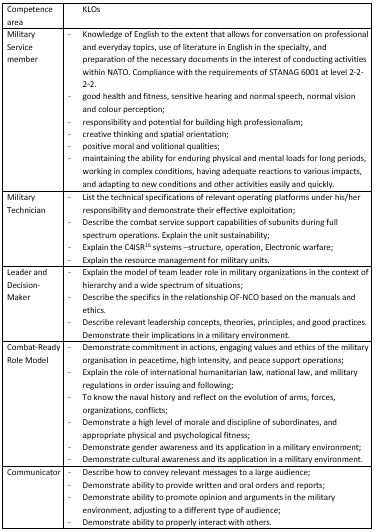
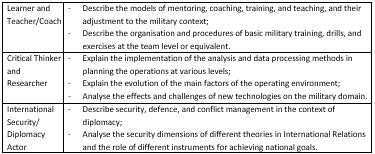
Table 2. KLOs of NVNA cadets’ curriculum. (Source: author’s research)
The comparative analysis requires matching NVNA’s KLOs with the learning outcomes of the relevant learning areas in SQF-MILOF. This is a creative process because it is impossible to have full compliance between both sides. Matching is the most creative and challenging part of this analysis. During this step, another generalization of the KLOs has to be made to summarize the main idea and formulate the essence for the learning areas within the framework of the competence areas.
The comparative analysis requires matching NVNA’s KLOs with the learning outcomes of the relevant learning areas in SQF-MILOF. This is a creative process because it is impossible to have full compliance between both sides.
Table 3 shows an example of a comparative analysis result. Columns 1 and 2 show defined KLOs and corresponding MILOF-CORE learning outcomes, respectively. Columns 3 and 4 are marked with the corresponding SQF-MILOF level and MILOF-CORE focus, respectively.
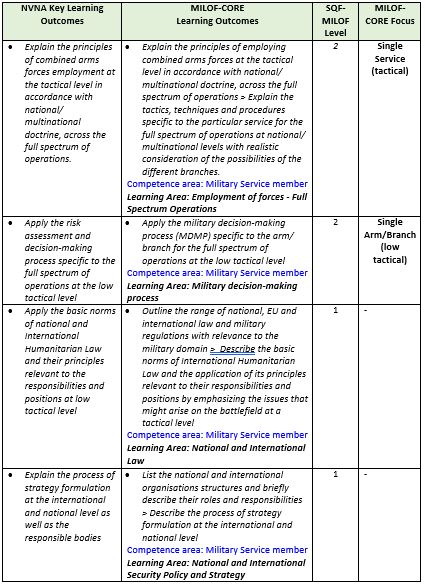

Table 3. Result of matching the KLOs with the learning outcomes of the relevant learning areas in MILOF-CORE focus and at the appropriate SQF-MILOF level. (the table is created by the author)
The conducted analysis yielded the following results:
- Fifteen KLOs were assessed to be equivalent to EQF Level 6 of SQF-MILOF and eleven KLOs were assessed to be equivalent to EQF Level 5. The core competence areas that cover professional competencies (specific to the sector) were assessed to be equivalent to Level 6 for the most part (13 vs. 6).
- Eight KLOs are focused on Single Arm/Branch (low tactical level) while one focuses on tactical level.
Conclusion
Based on these results, the main conclusion is that an informal validation of the SQF-MILOF is successful. That is, the defined SQF-MILOF Level 2 equals Bulgarian NQF Level 6. Notably, as the NQF is in full compliance with EQF, it can be concluded that– SQF-MILOF Level 2 is equivalent to EQF Level 6 (that was а supposition when developing SQF-MILOF).
Based on these results, the main conclusion is that an informal validation of the SQF-MILOF is successful. That is, the defined SQF-MILOF Level 2 equals Bulgarian NQF Level 6.
Because the analysis in the paper is limited to the SQF-MILOF Level 2, it is necessary to assess at minimum one more level (e.g., Level 3) to consider the validation as generalizable. Once validated, the SQF MILOF will help member states to reference their own curriculums and courses and facilitate cadets and officer’s educational mobility in sense of Erasmus+ program. The EU Common Security and Defence Policy will benefit from SQF MILOF implementation through aligning the member state’s educational efforts and creating common understanding of educational and qualification requirements.
CAPT (N) Nedko Dimitrov, Ph.D. Assoc. professor, Nikola Vaptsarov Naval Academy (NVNA); Dimitrov has researched the following areas: national security, critical infrastructure protection, risk management, and education and qualification aspects. The views contained in this article are the author’s alone and do not represent the views of NVNA.
[1] Sectoral Qualification Framework for Military Officers.
[2] European Qualification Network.
[3] The IG (“Comparison of courses based on competences,” IG/2014/002 (rev 4), ESCD, September 24, 2014, leads the Military Erasmus program,
[4] “Call for contribution – Sectoral Qualifications Framework for the Military Officer Profession,” Ares(2017) 6171521, December 15, 2017.
[5] “Sectoral Qualifications Framework for the Military Officer Profession,” ESDC/2020/234, July 12, 2020, https://esdc.europa.eu/sqf-milof/.
[6] European Qualification Network, last accessed May 08, 2022, https://europa.eu/europass/en/european-qualifications-framework-eqf.
[7] National Qualification Frameworks.
[8] “Sectoral Qualifications Framework for the Military Officer Profession,” ESDC/2020/234, July 12, 2020, https://esdc.europa.eu/sqf-milof/.
[9] Levels 1-4 of SQF MILOF are used in order to create the military qualification taxonomy. It was supposed that SQF MILOF levels 1-4 correspond to EQF levels 5-8, respectively.
[10] Each of the 8 levels of the EQF is defined by a set of descriptors indicating the learning outcomes (Knowledge, Skills, Responsibility and autonomy) relevant to qualifications at that level in any qualifications system, https://europa.eu/europass/en/description-eight-eqf-levels.
[11] State ordinance for minimum requirements to acquire higher education on the educational and qualification degree “bachelor” in the professional field “Military affairs” in the specialties of the regulated profession “tactical level officer”(“Наредба за държавните изисквания за придобиване на висше образование на образователно-квалификационна степен „бакалавър” в професионално направление „Военно дело” по специалностите от регулираната професия „офицер за тактическо ниво на управление”,” Ministry of Education, April 09, 2012, last accessed April 09, 2022, https://www.mon.bg/upload/4191/nrdb_edi_ofitser.pdf.
[12] State ordinance for minimum requirements to acquire higher education on the educational and qualification degree “master” in the professional field “Military affairs” in the specialties of the regulated profession “operational level officer”Наредба за държавните изисквания за придобиване на висше образование на ОКС “магистър” в ПН “Военно дело” по специалностите от регулираната професия “офицер на оперативно ниво на управление”,” April 09, 2012, last accessed April 08, 2022, https://web.mon.bg/bg/59.
[13] “Sectoral Qualifications Framework for the Military Officer Profession,” ESDC/2020/234, July 12, 2020, https://esdc.europa.eu/sqf-milof/.
[14] Idem.
[15] The table in section 05, MILOF-CORE of the “Sectoral Qualifications Framework for the Military Officer Profession,” ESDC/2020/234, July 12, 2020, https://esdc.europa.eu/sqf-milof/.


